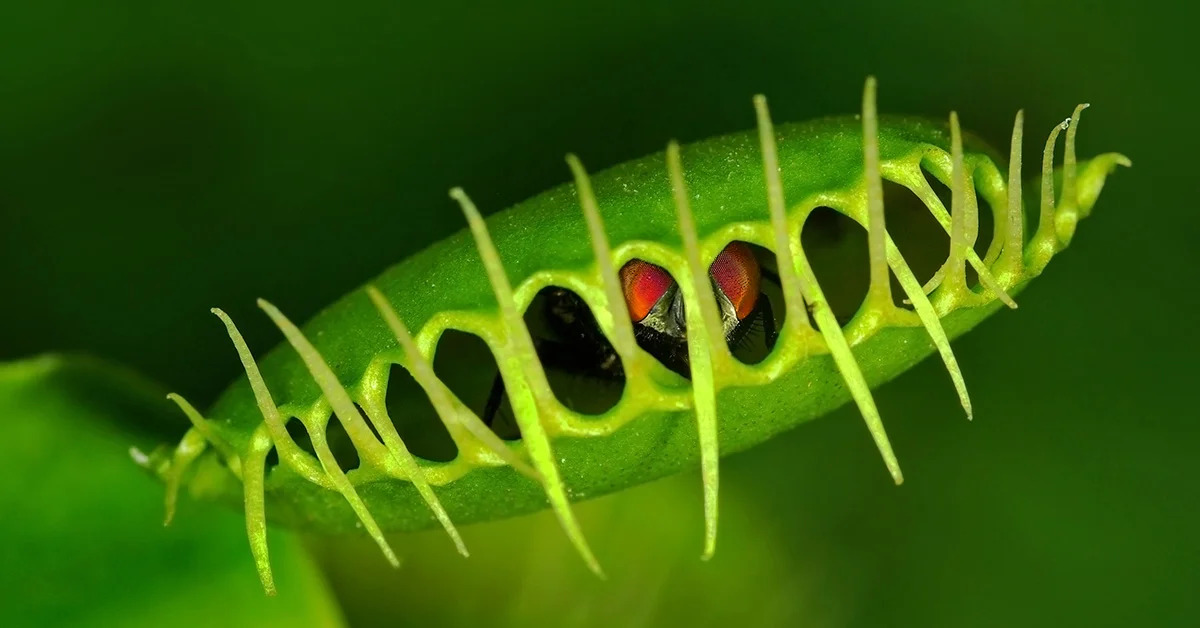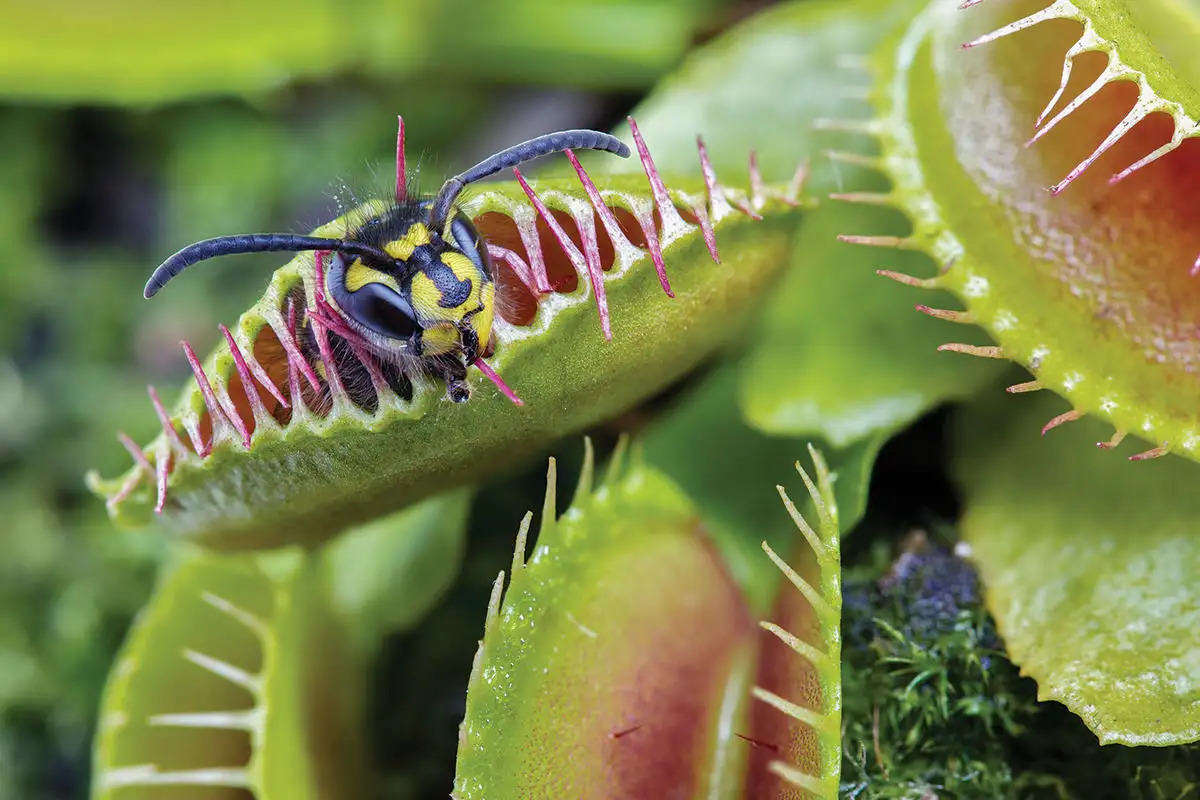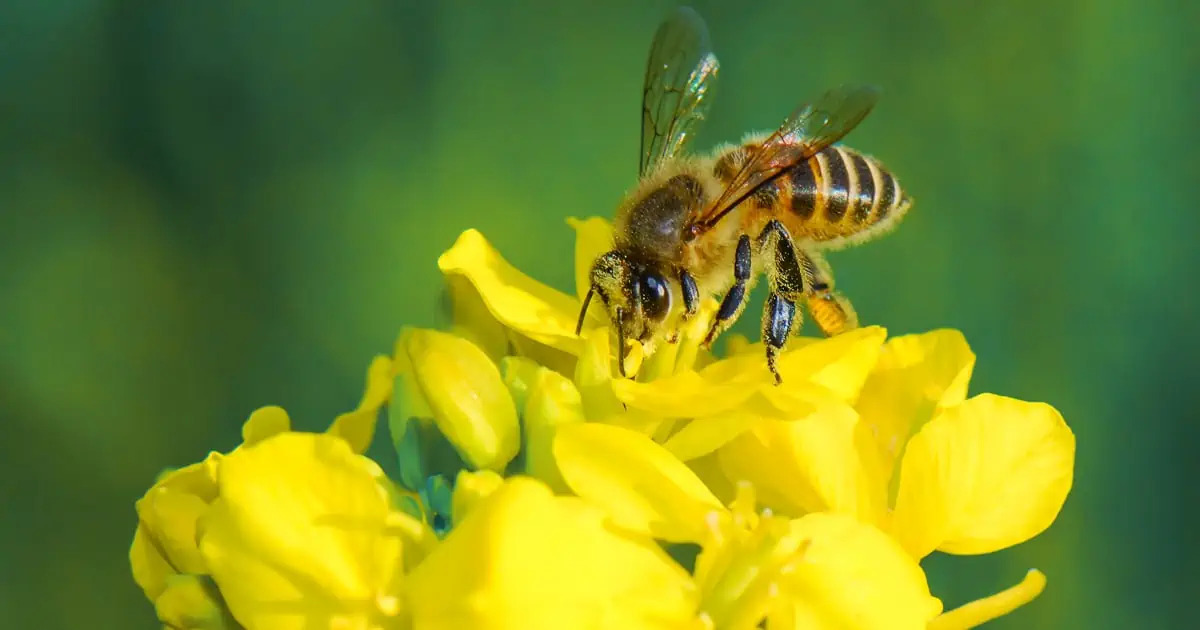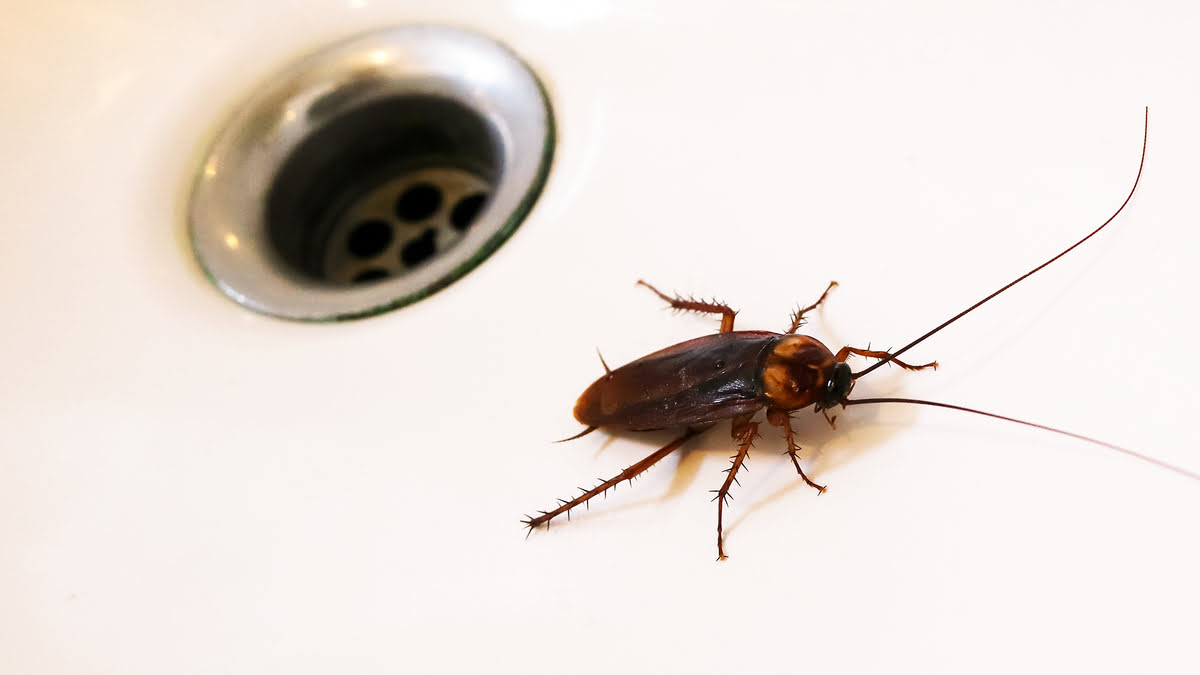Home>Gardening News and Trends>Latest News>Why Do Carnivorous Plants Digest Insects?


Latest News
Why Do Carnivorous Plants Digest Insects?
Modified: January 22, 2024
Discover the fascinating reason behind why carnivorous plants consume insects in the latest news.
(Many of the links in this article redirect to a specific reviewed product. Your purchase of these products through affiliate links helps to generate commission for Chicagolandgardening.com, at no extra cost. Learn more)
Table of Contents
Introduction
Welcome to the fascinating world of carnivorous plants! These extraordinary species have evolved unique adaptations that allow them to capture, digest, and absorb nutrients from insects. While it may seem peculiar for plants to consume animals, carnivorous plants have developed this behavior as a survival mechanism in nutrient-poor environments. Through their incredible evolutionary journey, they have become skilled predators, specializing in attracting, capturing, and digesting their prey.
Carnivorous plants can be found in various habitats worldwide, from nutrient-deficient bogs and marshes to rocky outcrops. Their ability to derive essential nutrients such as nitrogen and phosphorus from insects has given them a competitive advantage in these challenging environments.
Throughout this article, we will delve into the fascinating mechanisms behind why carnivorous plants digest insects. We will explore the evolutionary adaptations that have enabled them to adopt such a unique survival strategy, as well as the importance of insect digestion for their overall health and development.
In addition, we will discuss the benefits that carnivorous plants derive from insect digestion, shedding light on the intricate symbiotic relationships they form with their prey. So, sit back, relax, and let’s embark on this journey into the captivating world of carnivorous plants and their remarkable ability to digest insects.
Evolutionary Adaptations of Carnivorous Plants
The evolutionary adaptations of carnivorous plants are a testament to their remarkable ability to adapt to harsh, nutrient-deprived environments. Over millions of years, these plants have developed unique traits that allow them to capture, digest, and absorb nutrients from insects and other small prey.
One of the key adaptations of carnivorous plants is the modification of their leaves. These plants have evolved specialized structures, such as pitcher-shaped leaves, sticky traps, or snap traps, to effectively capture their prey. For example, the pitcher plants have elongated, tubular leaves that contain a fluid-filled reservoir at the base. Insects are lured into the pitcher by nectar or bright colors, only to find themselves trapped in the slippery inner walls, where they eventually drown.
Another adaptation is the secretion of digestive enzymes. Carnivorous plants produce a variety of enzymes, such as proteases and nucleases, which aid in breaking down the proteins and nucleic acids of their prey. These enzymes are often produced in specialized glands located on the inner surfaces of the trapping structures.
Furthermore, carnivorous plants have also developed mechanisms to prevent self-digestion. They produce inhibitors that prevent the digestive enzymes from harming their own tissues. This self-regulation is crucial to ensure that only the captured prey is digested while the plant remains unharmed.
These evolutionary adaptations have allowed carnivorous plants to expand their ecological niche and thrive in nutrient-poor environments. By supplementing their nutrient intake through insect digestion, they have gained a competitive advantage over other plant species. In fact, some carnivorous plants have even adapted to different types of prey, such as small vertebrates or spiders, further expanding their dietary repertoire.
The fascinating evolutionary journey of carnivorous plants continues to intrigue scientists, who study these unique adaptations to gain insights into the complex interplay between plants and their environment. Through these remarkable adaptations, carnivorous plants have carved out a distinct niche in the plant kingdom, captivating our imagination and inspiring us to explore the wonders of the natural world.
Nutritional Requirements of Carnivorous Plants
Carnivorous plants have evolved the ability to digest insects as a means to supplement their nutrition in nutrient-deficient environments. These plants often grow in habitats where the soil lacks essential nutrients, such as nitrogen and phosphorus. As a result, they have developed unique adaptations to obtain these vital elements from their prey.
The nutritional requirements of carnivorous plants differ significantly from those of non-carnivorous plants. While most plants obtain nutrients from the soil, carnivorous plants have adapted to obtain nutrients from the bodies of their captured prey. This adaptation is particularly important for nitrogen, an essential element for plant growth. Nitrogen is often limited in nutrient-poor environments, making it a crucial resource for plant survival and reproduction.
By consuming insects, carnivorous plants acquire the nitrogen they need in the form of proteins and amino acids. The digestive enzymes produced by these plants break down the proteins in the insect’s body into smaller molecules that can be absorbed and used by the plant. This enables carnivorous plants to meet their nutritional needs in nitrogen-deficient habitats.
In addition to nitrogen, carnivorous plants also require other essential nutrients, such as phosphorus, potassium, and trace elements. While these elements can also be obtained from the soil, carnivorous plants have developed strategies to compensate for the low availability of these nutrients in their surroundings.
One such strategy is the absorption of prey-derived nutrients through specialized structures, such as the roots or the inner walls of the trapping structures. These structures are equipped with small hairs and glands that facilitate the absorption of nutrients released during the digestion process.
Furthermore, carnivorous plants have evolved mechanisms to efficiently recycle and reutilize the nutrients derived from digested prey. The plants can remobilize and transport these nutrients to different parts of their bodies, ensuring efficient nutrient utilization and minimal wastage. This ability to recycle nutrients is crucial for the long-term survival and growth of carnivorous plants in nutrient-poor habitats.
The unique nutritional requirements of carnivorous plants highlight their remarkable adaptation to survive in challenging environments. By using insects as a source of essential nutrients, these plants have found a creative solution to overcome the limitations imposed by nutrient deficiency. The ability to utilize prey as a nutritional resource has granted them a competitive advantage in their ecological niche and has allowed them to thrive in habitats where other plants struggle to survive.
Mechanism of Insect Capture
Carnivorous plants have evolved a variety of mechanisms to capture insects and other small prey. These mechanisms are highly specialized and often depend on the specific type of carnivorous plant and its habitat. Let’s explore some of the fascinating strategies that these plants have developed to effectively capture their prey.
One common mechanism used by carnivorous plants is the use of traps. Different types of traps exist, each designed to lure and ensnare unsuspecting insects. One example is the snap trap, famously exhibited by the Venus flytrap. This plant has modified leaves with trigger hairs that, when touched by an insect, cause the leaves to snap shut rapidly, trapping the prey inside.
Another type of trap is the sticky trap, employed by plants like sundews and butterworts. These plants have leaves covered in glandular hairs that secrete a sticky substance. When an insect lands on these leaves, it becomes stuck to the surface. The more the insect struggles, the more it becomes entangled, eventually succumbing to exhaustion or suffocation.
Pitcher plants, on the other hand, use a passive pitfall trap. These plants have specialized tube-shaped leaves called pitchers that contain a pool of liquid at the base. Insects are lured into the pitcher by bright colors, attractive fragrances, or nectar secretions. Once inside, they become trapped in the liquid and are unable to escape due to the slippery walls. Some pitcher plants even possess downward-pointing hairs that make it difficult for prey to climb back out.
Another clever strategy used by carnivorous plants is the use of sticky mucilage. This is exemplified by plants like the bladderwort, which are aquatic carnivorous plants. Bladderworts possess bladder-like structures with tiny trigger hairs. When an insect touches these hairs, the bladder rapidly opens, creating a vacuum that sucks the prey inside, where it becomes trapped and digested.
These mechanisms of insect capture highlight the ingenious tactics employed by carnivorous plants to secure their food source. By attracting and entrapping their prey, these plants ensure a steady supply of nutrients, enabling them to thrive in nutrient-deficient environments.
Enzymatic Digestion of Insects
Once carnivorous plants have successfully captured their prey, the next step is to break down and digest the insect’s body to obtain the essential nutrients they require. This process involves the secretion of a variety of digestive enzymes that help in the breakdown of proteins, nucleic acids, and other macromolecules present in the insect’s body.
The digestive enzymes produced by carnivorous plants are highly specialized and catered toward the specific types of nutrients found in insects. One of the key enzymes involved in the digestion process is protease, which breaks down proteins into amino acids. These amino acids are crucial for the growth and development of the plants.
In addition to proteases, carnivorous plants also produce other enzymes, such as lipases, nucleases, and glycosidases. Lipases are responsible for breaking down lipids (fats), while nucleases help in the degradation of nucleic acids (DNA and RNA). Glycosidases, on the other hand, are involved in the breakdown of carbohydrates present in the insect’s body.
Collectively, these digestive enzymes work together to break down the insect’s body into smaller molecules that can be absorbed and utilized by the carnivorous plants. This enzymatic digestion process takes place within specialized digestive glands that line the inner surfaces of the trapping structures, such as the pitcher of a pitcher plant or the leaves of a sundew.
Interestingly, the production of digestive enzymes by carnivorous plants is regulated and responsive to the presence of prey. When an insect is captured, the plants detect its presence through chemical cues, such as the secretion of nectar or the physical touch of the prey. In response to these stimuli, the plants commence the production and secretion of the appropriate digestive enzymes.
It is worth noting that carnivorous plants have also developed mechanisms to prevent self-digestion. They produce inhibitors that prevent the digestive enzymes from harming their own tissues. This ensures that only the trapped prey is targeted for digestion while protecting the plant itself.
The enzymatic digestion of insects plays a vital role in providing carnivorous plants with the necessary nutrients to survive and thrive in nutrient-poor environments. Through the secretion of specialized digestive enzymes, these plants have evolved an efficient and effective means of utilizing the nutrients present in their captured prey.
Importance of Insect Digestion for Carnivorous Plants
The process of insect digestion holds immense importance for carnivorous plants as it provides them with essential nutrients necessary for their growth, development, and survival. In nutrient-poor environments where these plants typically thrive, the ability to capture and digest insects becomes a crucial adaptation that enables them to overcome the limitations imposed by the lack of available nutrients.
One of the primary reasons why insect digestion is important for carnivorous plants is that it allows them to obtain nitrogen, a vital nutrient required for various physiological processes. Nitrogen is an essential component of proteins, nucleic acids, and chlorophyll, and is crucial for plant growth and development. By digesting insects, carnivorous plants gain access to a rich source of nitrogen in the form of proteins and amino acids.
Insect digestion also provides carnivorous plants with other essential nutrients, such as phosphorus, potassium, and trace elements. These nutrients are often limited in nutrient-poor environments, but by capturing and digesting insects, carnivorous plants are able to supplement their nutrient intake and ensure they have a well-rounded diet.
Another important aspect of insect digestion for carnivorous plants is the acquisition of energy. Insects, being rich in carbohydrates and lipids, serve as a valuable energy source for these plants. The digestion and absorption of insect nutrients provide the necessary energy for metabolic processes, growth, reproduction, and defense mechanisms.
Furthermore, insect digestion plays a crucial role in the overall health and functioning of carnivorous plants. By removing potential competitors in the form of insect pests, these plants can reduce predation damage and enhance their own survival. Insect digestion also helps maintain the balance of nutrients within the plant, preventing imbalances or deficiencies that could hinder their growth and development.
Moreover, the act of digesting insects allows carnivorous plants to engage in intricate symbiotic relationships. Certain species of carnivorous plants have developed specialized relationships with bacteria or other microorganisms that aid in digestion. These microorganisms assist in breaking down complex compounds within the insect’s body, further facilitating nutrient absorption by the plant.
Overall, the digestion of insects provides carnivorous plants with a means to acquire essential nutrients, obtain energy, and maintain their overall health and functioning. This adaptation has allowed these fascinating plants to thrive in challenging environments, where traditional nutrient sources are scarce. The ability to utilize and digest insects showcases the remarkable ingenuity and resourcefulness of carnivorous plants in their quest for survival.
Benefits of Insect Digestion for Carnivorous Plants
The process of insect digestion provides a multitude of benefits for carnivorous plants, contributing significantly to their overall growth, development, and ecological success. Let’s explore some of the key advantages that carnivorous plants derive from digesting insects.
1. Nutritional Supplementation: Insect digestion offers carnivorous plants a valuable source of essential nutrients, such as nitrogen, phosphorus, and trace elements. These nutrients are often limited in their natural habitats, and by capturing and digesting insects, the plants can ensure a steady supply of vital nutrients that are necessary for their metabolic processes and overall health.
2. Adaptation to Nutrient-Poor Environments: Carnivorous plants have evolved to thrive in nutrient-poor environments, and insect digestion plays a crucial role in this adaptation. By supplementing their nutrient intake through the consumption of insects, these plants have gained a competitive advantage over non-carnivorous species that solely rely on soil nutrients. This adaptation allows carnivorous plants to colonize and flourish in habitats where traditional nutrient sources are limited or scarce.
3. Energy Acquisition: Insect digestion provides carnivorous plants with an additional energy source, particularly in the form of carbohydrates and lipids present in insects’ bodies. This energy fuels their metabolic activities, including growth, reproduction, and defense mechanisms, allowing them to achieve optimal physiological functioning and overall fitness.
4. Pest Control: The ability of carnivorous plants to capture and digest insects also serves as a natural form of pest control. By targeting and eliminating potential insect pests, these plants help regulate insect populations within their habitats. This reduction in pest pressure further contributes to the overall health and survival of both the carnivorous plants themselves and the surrounding ecosystem.
5. Symbiotic Relationships: Insect digestion in carnivorous plants often involves complex symbiotic relationships with microorganisms. These microorganisms, such as bacteria and fungi, aid in the breakdown of complex compounds within the insect’s body, making the nutrients more accessible for the plant. These symbiotic associations enhance the efficiency of nutrient absorption and utilization, benefiting both the microorganisms and the carnivorous plants.
6. Evolutionary Success: The ability to capture and digest insects has played a pivotal role in the evolutionary success of carnivorous plants. This unique adaptation has allowed them to occupy niche habitats where other plant species struggle to survive due to nutrient limitations. By diversifying their nutrient acquisition strategies, carnivorous plants have expanded their ecological range and diversified their species, contributing to their long-term evolutionary persistence.
The benefits of insect digestion for carnivorous plants are not only limited to their individual growth and survival but also extend to their ecological interactions and the functioning of their respective ecosystems. Through their unique ability to digest insects, these plants have established fascinating and intricate relationships with their environment, reinforcing the marvel of adaptation and highlighting the remarkable diversity of life on our planet.
Conclusion
Carnivorous plants have captivated the world with their unique ability to capture, digest, and derive essential nutrients from insects. Through evolutionary adaptations, these plants have developed mechanisms such as specialized traps and the secretion of digestive enzymes to effectively capture and break down their prey. Insect digestion plays a vital role in meeting the nutritional requirements of carnivorous plants, providing them with crucial elements like nitrogen, phosphorus, and energy that are often limited in their nutrient-poor habitats.
The importance of insect digestion for carnivorous plants cannot be overstated. It allows these plants to not only survive but also thrive in challenging environments where traditional nutrient sources are scarce. The ability to supplement their nutrient intake through insect digestion has given carnivorous plants a competitive advantage and enabled them to colonize niche habitats that other non-carnivorous plants struggle to inhabit.
The benefits of insect digestion extend beyond mere nutrient supplementation. It also acts as a form of pest control, helping to regulate insect populations within their ecosystems. This, in turn, contributes to the overall health and balance of the ecosystem as well as the success of the carnivorous plants themselves.
The process of insect digestion in carnivorous plants is not just a physiological phenomenon; it represents the remarkable adaptations and sophisticated strategies that have evolved over millions of years. It showcases the ingenuity of nature and the incredible diversity of life forms on our planet.
Further research into the mechanisms of insect digestion and the unique adaptations of carnivorous plants continues to uncover new insights into their intricate relationships with their environment. As we delve deeper into the fascinating world of carnivorous plants, we gain a deeper appreciation for the wonders and complexities of the natural world.
So, the next time you come across a carnivorous plant, take a moment to marvel at its ingenious ways of capturing and digesting insects. Appreciate the brilliance of adaptation and the incredible strategies that these plants have developed to flourish in nutrient-poor habitats. The world of carnivorous plants is truly a testament to the resilience and resourcefulness of life in even the harshest of conditions.










